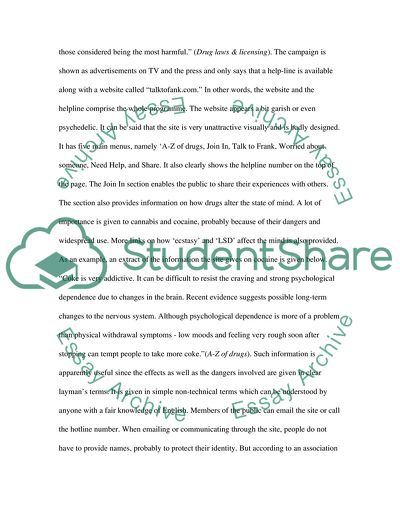Cite this document
(“Talk to Frank Programme Essay Example | Topics and Well Written Essays - 4000 words”, n.d.)
Talk to Frank Programme Essay Example | Topics and Well Written Essays - 4000 words. Retrieved from https://studentshare.org/miscellaneous/1553288-to-what-extent-do-strategies-applied-in-government-anti-drug-advertising-and-pr-campaigns-encourage-specific-audience-interpretations-of-their-messages-case-study-the-talk-to-frank-drug-awareness-campaign
Talk to Frank Programme Essay Example | Topics and Well Written Essays - 4000 words. Retrieved from https://studentshare.org/miscellaneous/1553288-to-what-extent-do-strategies-applied-in-government-anti-drug-advertising-and-pr-campaigns-encourage-specific-audience-interpretations-of-their-messages-case-study-the-talk-to-frank-drug-awareness-campaign
(Talk to Frank Programme Essay Example | Topics and Well Written Essays - 4000 Words)
Talk to Frank Programme Essay Example | Topics and Well Written Essays - 4000 Words. https://studentshare.org/miscellaneous/1553288-to-what-extent-do-strategies-applied-in-government-anti-drug-advertising-and-pr-campaigns-encourage-specific-audience-interpretations-of-their-messages-case-study-the-talk-to-frank-drug-awareness-campaign.
Talk to Frank Programme Essay Example | Topics and Well Written Essays - 4000 Words. https://studentshare.org/miscellaneous/1553288-to-what-extent-do-strategies-applied-in-government-anti-drug-advertising-and-pr-campaigns-encourage-specific-audience-interpretations-of-their-messages-case-study-the-talk-to-frank-drug-awareness-campaign.
“Talk to Frank Programme Essay Example | Topics and Well Written Essays - 4000 Words”, n.d. https://studentshare.org/miscellaneous/1553288-to-what-extent-do-strategies-applied-in-government-anti-drug-advertising-and-pr-campaigns-encourage-specific-audience-interpretations-of-their-messages-case-study-the-talk-to-frank-drug-awareness-campaign.


